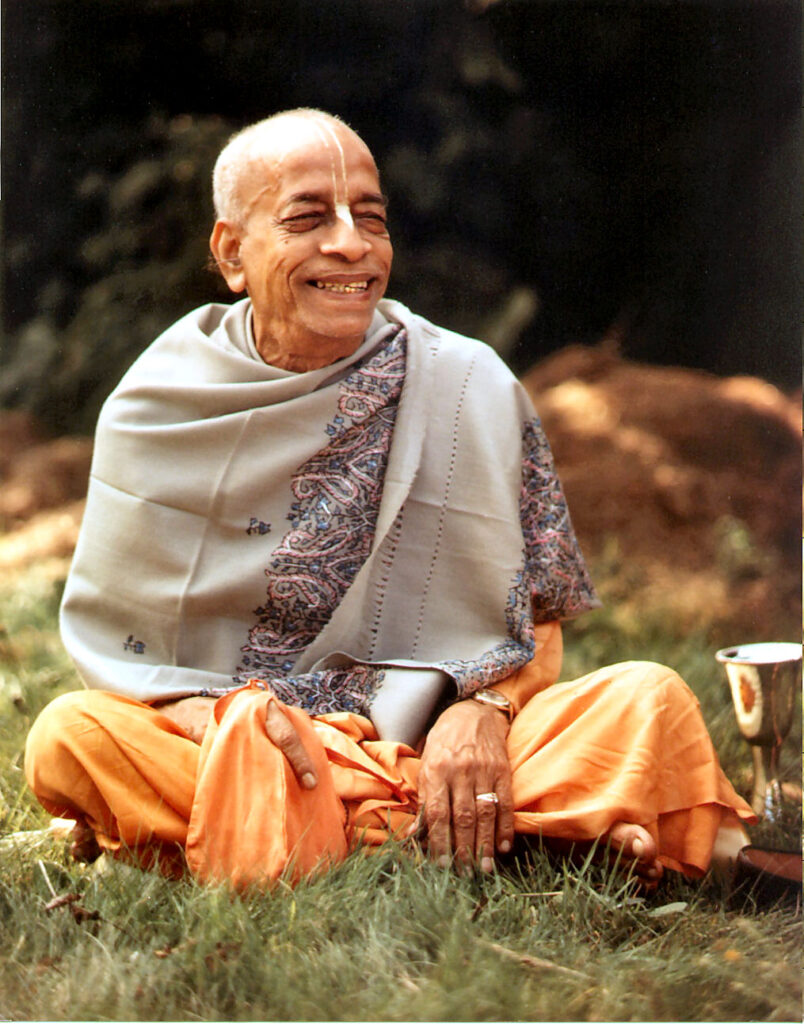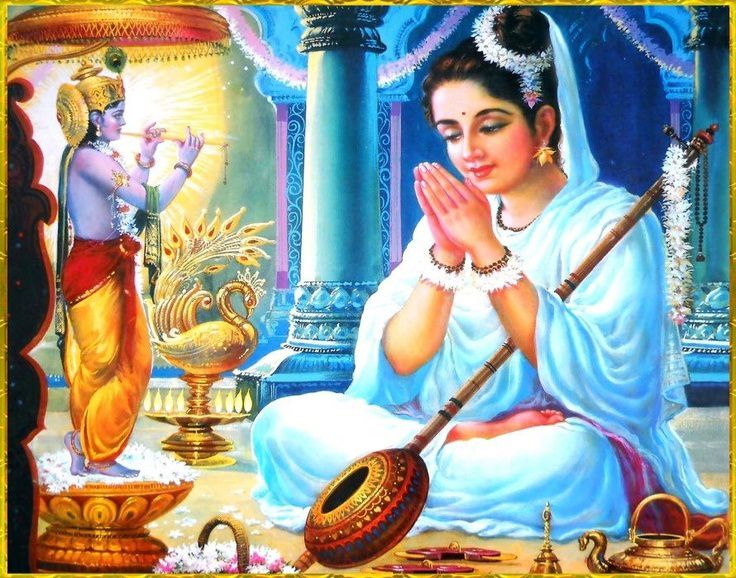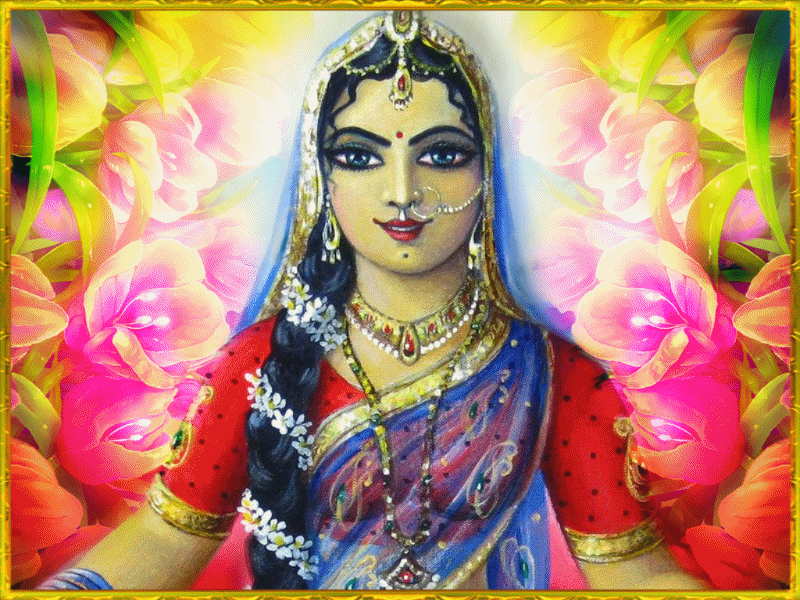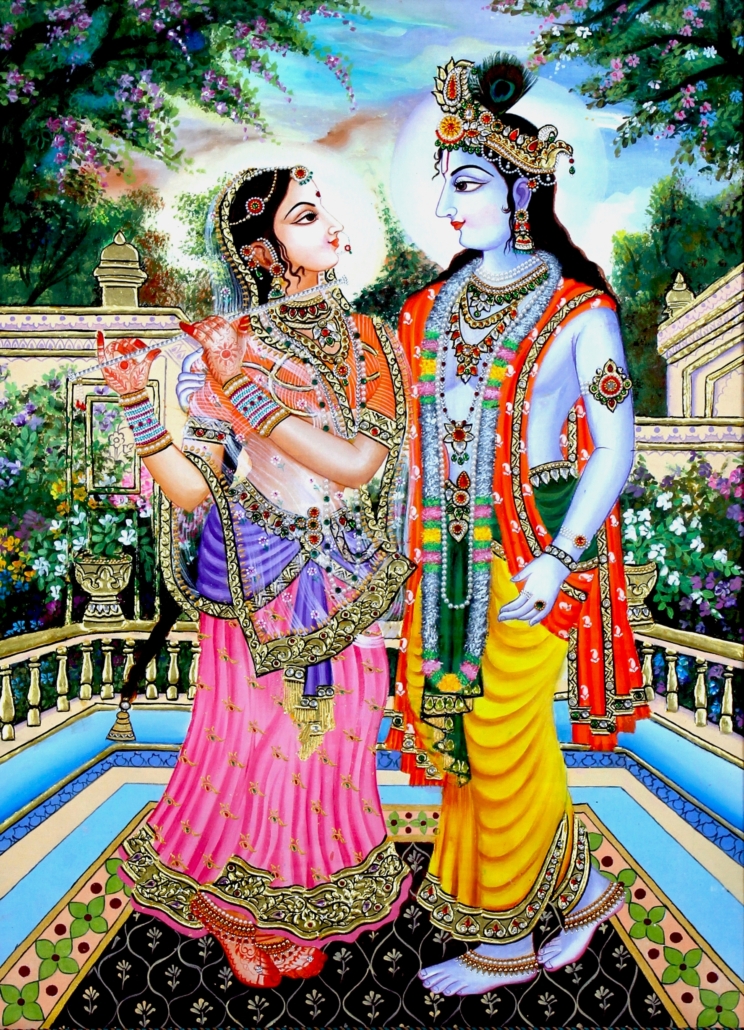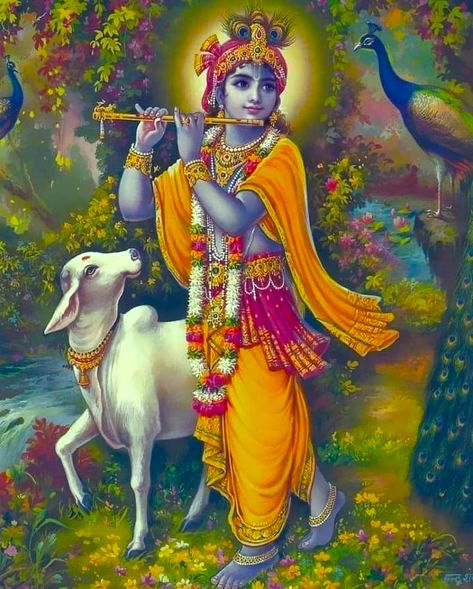Mahanidhi Madan Gopal Das
These amazingly sweet and charming nectar-filled verses will carry you into the kingdom of service to Srimati Radharani. The original Sanskrit verses of Radha Rasa Sudhanidhi, which are popular with many Vaisnavas, are all incomparably beautiful and worthy of remembrance.
However, since most people cannot memorize Sanskrit verses, we have presented mostly just English translations. These verses give wonderful lila pictures for meditating on Srimati Radhika with or without the chanting of Harinama japa.
2 Madhusudana, who is difficult to attain for even the king of yogis, feels greatly blessed by a mere touch of the playful breeze coming from the edge of Radhika’s cloth. I offer my obeisances to any direction where I can find this Vrishabhanunandini.
8 yat kinkarīshu bahushah, khalu kākuvānī
nityam parasya purushasya, shikhanda mauleh
tasyāh kadā rasa nidher, vrishabhanu jāyā
tat keli kunja bhavan āngana, mārjanī syām
Wearing a crown of peacock feathers, Sri Krishna, the Absolute Person, perpetually pleads with and flatters Radha’s maidservants to grant Him darshana of Radharani. When will I become a broom for sweeping the courtyard of the cottage in the play groves of Vrishabhanunandini—the ocean of rasa?
9 In Vrindavana, there is a divine jewel named Radha who is full of the rapturous nectar of beautiful moods and who liberates the saintly. O mind! Now just leave all great persons and things behind you and run to Vrindavana with love.
14 Radha karāvacita, pallava vallarīke
Radha padānka vilasan, madhura sthalī
Radha yasho mukhara, matta khagāvalīke
Radha vihāra vipine, ramatām mano me
May my mind find pleasure in the play forest of Radha; where the leaf buds and vines are touched by Radha’s hands; where the ground is sweetened by Radha’s footprints and lilas; and where the birds madly sing Radha’s glories.
17 Radhe! After You enjoy blissful pastimes throughout the night with Your rasika lover, I will bathe You and serve You some honey-sweet foods. When will You then fall asleep as I massage Your lotus feet with my hands?
18 vaidagdhya sindhur anurāga, rasaika sindhur
vātsalya sindhur ati sāndra, kṛpaika sindhuh
lāvaṇya sindhur amrita, cchabi rūpa sindhuḥ
sri radhika sphuratau me, hrdi keli sindhuh
Sri Radha embodies seven ocean which include an ocean of cleverness, anurāga rasa, motherly affection, deep compassion, elegance, play, and a nectar-ocean of glistening transcendental forms! When will this Sri Radha appear in my heart?
24 O Sri Radhike! When You go to a lonely place on the bank of the Yamuna, I will massage Your nectarean limbs that are the very life of Ananga, Cupid Sri Krishna, amritam angam ananga jivam. At that time, I will notice that the Youthful King of all paramours is sitting high above us in a kadamba tree immersed in admiring Your exquisite form.
32 saṅketa kunjam anu, pallavam āstarītuṁ
tat tat prasādam abhitaḥ, khalu samvarītum
tvāṁ shyamachandram abhisāra, yituṁ dhrtāshe
sri radhike mayi vidhehi, krpā kaṭāksham
O Sri Radhike! I want to make a bed of fresh sprouts in the trysting bower and arrange Your meeting with Shyamachandra. Cherishing this desire in my heart, I beg for Your sidelong glance of mercy.
38 In separation from Shyama, Radhika passes the day constantly lamenting with anxious eyes while sighing, ‘O most beautiful Shyama! O enchanter of My mind! O wonderful lover, You are as charming as crores of Cupids!’ (shyāmeti sundara vareti, mano hareti kandarpa koṭi, laliteti su nāgareti)
39 veṇuḥ karān nipatitaḥ, skhalitaṁ shikhandam
bhrashtam ca pīta vasanam, vraja raja sūnoḥ
yasyāḥ kaṭāksha shara, ghāta vimūrcchitastya
tāṁ rādhikāṁ paricar, āmi kadā rasena
When will I happily serve that Radhika whose arrow-like glance strikes Vrajendranandana to make His flute fall from His hand; His peacock feather crown slip off; and His yellow dhoti drop down as He faints?
40 Even great devatas like Brahmaji and others cannot attain Radhika, who is the source of the most amazing topmost bliss, and the embodiment of playful pastimes for Krishna who Himself is the essence of endless loving mellows. O Vrishabhanunandini, birth after birth may I be your maidservant?
43 When will I become eager to take Vrishabhanunandini, Who is shy and afraid of Her first meeting with the king of debauchees, by Her lotus-like hand and bring Radha to the play-bed in the trysting-bower which is made of soft fresh sprouts?
44 sad gandha mālya nava, chandra lavaṅga saṅga
tāmbūla sampuṭam adhīsh, vari mām vahantīm
shyāmam tam unmada rasād, abhisaṁ sarantī
sri rādhike karuṇa, yānucariṁ vidhehi
O my Ishvari Radha! When You madly rush out to meet Shyama will You kindly accept me as Your maidservant, and let me carry some quality perfumes, garlands, and a box of fresh betel leaves mixed with fresh camphor and cloves?
48 kunj āntare kim api, jāta rasot savāyāḥ
shrutvā tad ālapita, sinjita mishritāni
sri rādhike tava rahaḥ, paricāri kāhaṁ
dvāra sthitā rasa hrade, patitā kadā syām
O Sri Radhike! When will I be Your confidential maidservant, and fall into a pool of rasa while standing at the kunja gate listening to the sweet jingling of Your ornaments mixing with the sweet sound of Your love prattles with Krishna in the beginning of Your festival of love?
53 When will I see myself in Vrindavana as a very tender adolescent maidservant, wearing Swamini’s prasadi dress and a silken blouse lovingly given to me by Her own hand (prasadam svaminyah svakaratala dattam pranayatah)? I will always stay near Sri Radhika to expertly serve Her in various ways.
54 O Sri Radhe! When will I become an expert maidservant to serve You by separating Your tangled hair with my fingernails, or place a silken blouse on Your lustrous jug-like breasts, or fasten jeweled anklebells on Your graceful ankles?
55 May I always meditate upon Radha’s tender lotus feet as I loudly and very affectionately sing Hari’s name to Her, and offer perfumes and other items to Her while blissfully following behind Radha in Vrindavana?
59 The cheeks of Sri Radhika, the best of ladyloves, and Sri Krishna, the king of loving enjoyers, are moistened with sweat drops of fatigue from Their incomparable dancing during the rasa-lila which is full of wonder, mirth and enchantment. When will I joyfully serve Radha and Krishna by massaging Their feet and nicely fanning Them?
63 When will accompany Radha and on Her order tell Nandanandana, “O king of cheaters! My Ishvari will not go alone into that secluded Kadamba grove because She is afraid of You.” Although Radha is apparently rejecting Krishna’s repeated proposals to meet in a particular kunja, in reality Radha is indicating the same kunja.
76 O Nāgari Radha! When will I remove Krishna’s yellow cloth, mistakenly switched in the kunja, from Your body and give You another garment? When at daybreak will I run back to that love bower to retrieve Your forgotten blouse? When will I tie Your hair-braid, restring Your broken pearl necklace, paint eyeliner around Your eyes, and use colorful substances like musk or vermilion to hide the bruises on Your body caused by Krishna’s amorous sports?
87 labdhva dāsyaṁ tad ati kṛpayā, mohana svāditena
saundarya sri pada kamalayor, lālanaiḥ svāpitāyāḥ
sri Radhayā madhura madhura, occhishta pīyūsha sāraṁ
bhojam bhojam nava nava ras, ānanda magnaḥ kadā syām
When by Sri Radhika’s mercy will I attain Her seva, and become immersed in ever-new ecstasy as I massage Radha’s beautiful lotus feet while She sleeps and relishes Krishna’s enchanting sweetness? When will I become immersed in ever new blissful rasa by repeatedly eating Radha’s sweeter than sweet food remnants, which are the essence of nectar?
96 May the two supremely astonishing, blissful, desiring fulfilling, enchanting, love-filled and tasty syllables “RA DHA”, that are muttered by Sri Hari as He sits in a kunja cottage beside the Yamuna meditating with tear filled loving eyes on the effulgence of Radha’s lotus feet, always appear in my heart!
154 O Radhe! When will You and I have an indescribably wonderful talk, wherein each syllable emanates a matchless ocean of love that showers my cup-like ears with a stream of cool and mild nectar that melts with rasa and gives the highest bliss?
156 lulita nava lavaṇ godāra, karpūra pūraṁ
priyatama mukha candrod, gīrṇa tāmbūla khandaṁ
ghana pulaka kapola, svādayantī mad āsye
arpayatu kimapi dāsī-vatsalā karhi radha
When will indescribable Radha, who is affectionate to Her maidservants and whose cheeks are adorned with thrill bumps of bliss, give me the betel-nut prasadi from Priyatama’s moon-like mouth that is mixed with lovely fresh cloves and lots of camphor, by putting it in my mouth after She relishes it?
159 When can I serve Sri Radhika by fanning Her and giving Her fresh betel-leaves while She blissfully displays original artful dances with Her lover Madhupati and Her sakhis during the Rasa lila which is full of astonishingly tasty pastimes and madly ecstatic love?
166 When can I fan Radha and Krishna, who are covered in perspiration from Their vigorous amorous affairs, in such a way that They blissfully close Their eyes while enjoying the cool breeze as They relax outside the cottage of fresh creepers (nava lata mandira) beside the Yamuna?
191 O Radhe! When will I follow You and Shyama down the road, and totally enchant both Your hearts by pushing Your rasika lover away from You while saying: “O king of cheaters! Why are approaching our prana sakhi Radha, who becomes bewildered just like a young girl when You just touch the side of Her breasts?”
202 When will I drown in a pond of rasa while sweeping Sri Radhika’s enchanting play cottage, sprinkling it with liquid sandalwood paste, and singing about the supremely sweet and abundant nectarean rasa of Madhubhid’s wonderful character and pastimes?
208 O Radhike! When will I hide the signs of You and Your beloved’s amorous affairs from Your cruel superiors by saying: “My sakhi was picking flowers far away from here, and while hurrying back Radha’s breasts were bruised by thorns; the tilaka was washed from Her forehead by perspiration; and Radha’s lips were bruised by the cold wind!”
213 While softly massaging the lotus feet of Radha Madhupati, the personal forms of the most blissful, inebriating and tasty love, when will I somehow fall asleep at the end of Their bower bed?
219 O Pranayini Radhe! Whenever You are angry with Krishna, He falls at my feet with a straw between His teeth. Then Shyama prays to me with many pitiful words while continually following me, and asking me to arrange a meeting with You. O Radhe! When will I become upset with that and submit Shyama’s plea to You?
223 O Sri Radhe! When will I fulfill my desires by lovingly painting leaf-pictures on Your cheeks, eyeliner around Your eyes, lipstick on Your lips, vermilion on Your breasts and red lac on Your toes when You are nervous about Your new meeting with Krishna?
224 O Vrishabhanunandini! When will I tell Your Priyatama: “O Gopendra-kumara! Don’t tell such proud jokes in vain! With great endeavor You may have held one Govardhana Hill on Your hand. But You immediately become afraid just by seeing the golden mountains upon Sri Radha’s body!” ( sri radha tanu hema shaila yugale, drshte pi te syad bhayam)
246 May Sri Radha’s smile protect us when She sees Hari admiring His own reflection in Her shining golden breasts and hears Him say, “I see two beautiful boys on Your breasts whose luster removes the glories of hosts of blue lotus-flowers! I am completely enchanted by them. So please make Me Your girlfriend, so these boys can tightly embrace both of Us young girls!
247 O Radhike! When will I, just after You meet Shyama at the start of Your love festival, hear You sarcastically tell Shyama: “O Knower of morality, stay away from Me!” Then I will watch You push away Krishna’s hand and storm out of the kunja. With tear-filled eyes, You will then angrily lament to Your girlfriends that You just saw some other girl reflected in Krishna’s Kaustubha gem on Your lover’s chest. [although it was actually Radha’s own reflection]
254 sadā gāyaṁ gāyaṁ madhuratara, radha priya yashaḥ
sadā sāndrānanda nava rasada radha, rati kathāḥ
sadā sthāyaṁ sthāyaṁ nava nibhṛta radha, rati vane
sadā dhyāyaṁ dhyāyaṁ vivasha hṛdi radha, pada sudhāḥ
I always sing about the sweeter then sweet glories of Radha’s beloved Shyama. I always speak about the fresh, condensed and blissful rasa-filled talks of Radha’s love. I always dwell in fresh solitary love-forest of Radha. And my heart is always overwhelmed by meditating on the nectar flowing from the feet of Radha.
259 While holding in my heart the desire to attain the supremely cherished service of Sri Radha’s lotus-feet, I always meditate on Krishna wearing a crown of peacock-feathers; and sing Krishna nama in sankirtana; serve Krishna’s lotus-feet (murti) and murmur His best of mantras. When by Krishna’s mercy will Radha-Madhava’s grand festival of divine love arise in my heart?
Manjari bhava upasana ki jai! Radharani ki jai! Jaya Jaya Sri Radhe!

